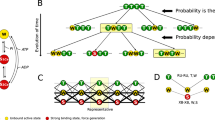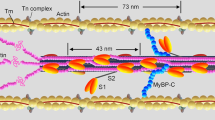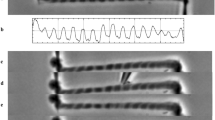Abstract
IT has been established that the elastic properties of contracting skeletal muscle are dominated by structures within the sarcomeres. We have demonstrated1 a decrease in the instantaneous stiffness of a contracting toad sartorius at lengths greater than body length (l0) coinciding directly with the decline in maximum isometric tetanic tension. This finding suggested that the cross bridges between actin and myosin filaments may be the major site of compliance in an active muscle, a conclusion in accordance with that reached by Huxley and Simmons2 on the basis of a study of tension transients following rapid releases in single fibres of frog semitendinosus. Also in agreement with this conclusion is the work of Cleworth and Edmond3 who used a light diffraction technique to demonstrate that any change in the length of the sarcomere during isometric contraction was less than 50 Å, or less than 0.1 %. These studies suggest that the cross links could be the major site of elasticity within the sarcomere, but it is possible that significant compliance resides in the unbonded thin filaments, although X-ray diffraction studies of contracting muscle4 indicate that the I-filament length does not increase by more than 0.02%. The experiments reported here were carried out to extend previous observations of muscle stiffness into the range of lengths below the resting length.
This is a preview of subscription content, access via your institution
Access options
Subscribe to this journal
Receive 51 print issues and online access
$199.00 per year
only $3.90 per issue
Buy this article
- Purchase on Springer Link
- Instant access to full article PDF
Prices may be subject to local taxes which are calculated during checkout
Similar content being viewed by others
References
Bressler, B. H., and Clinch, N. F., J. Physiol., Lond., 237, 477–493 (1974).
Huxley, A. F., and Simmons, R. M., Nature, 233, 533–538 (1971).
Cleworth, D. R., and Edman, K. A. P., J. Physiol. Lond., 227, 1–17 (1972).
Huxley, H. E., and Brown, W., J. molec. Biol., 30, 383–434 (1967).
Ramsey, R. W., and Street, S. F., J. cell. comp. Physiol., 15, 11–34 (1940).
Sandberg, J. A., and Carlson, F. D., Biochem. Z., 345, 212–231 (1966).
Aubert, X., Le Couplage Energetique de la Contraction Musculaire (Editions Arscia, Bruxelles, 1956).
Gordon, A. M., Huxley, A. F., and Julian, F. J., J. Physiol., Lond., 184, 170–192 (1966).
Simmons, R. M., J. Physiol., Lond., 212, 20P (1970).
Huxley, A. F., and Simmons, R. M., J. Physiol., Lond., 218, 59P (1971).
Author information
Authors and Affiliations
Rights and permissions
About this article
Cite this article
BRESSLER, B., CLINCH, N. Cross bridges as the major source of compliance in contracting skeletal muscle. Nature 256, 221–222 (1975). https://doi.org/10.1038/256221a0
Received:
Accepted:
Issue Date:
DOI: https://doi.org/10.1038/256221a0
This article is cited by
-
A comparison of isometric force, maximum power and isometric heat rate as a function of sarcomere length in mouse skeletal muscle
Pfl�gers Archiv European Journal of Physiology (1992)
-
The effect of length range on heat rate and power during shortening nearin situ length in frog muscle
Journal of Muscle Research and Cell Motility (1986)
Comments
By submitting a comment you agree to abide by our Terms and Community Guidelines. If you find something abusive or that does not comply with our terms or guidelines please flag it as inappropriate.



